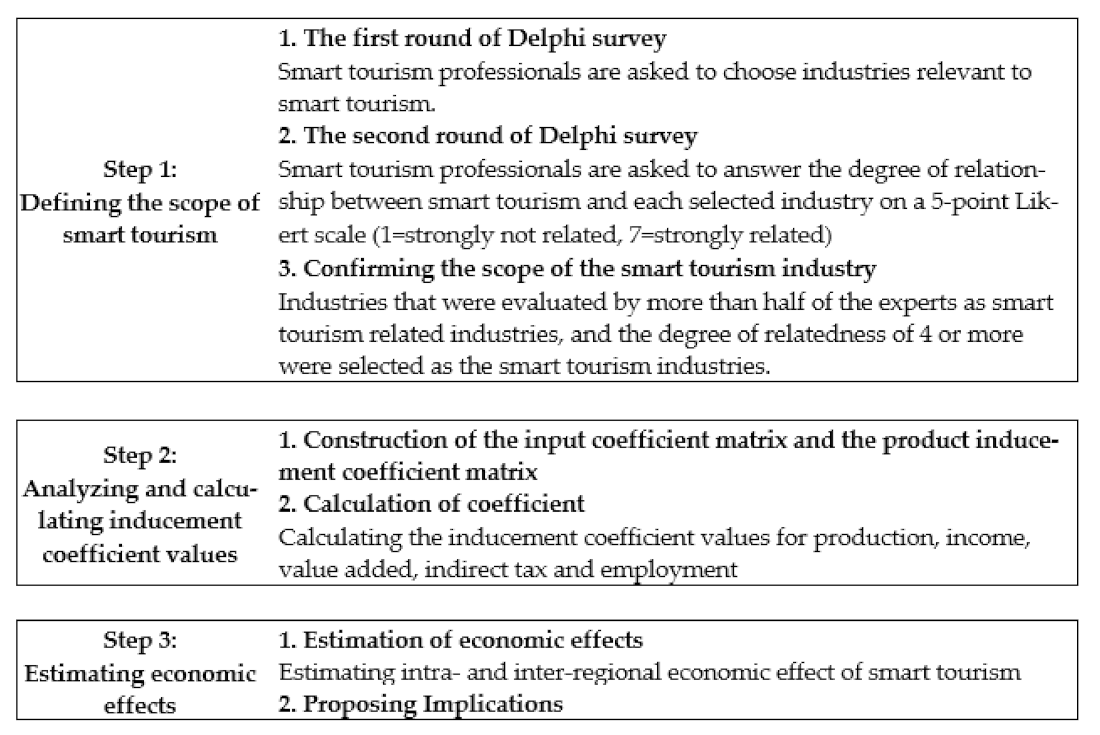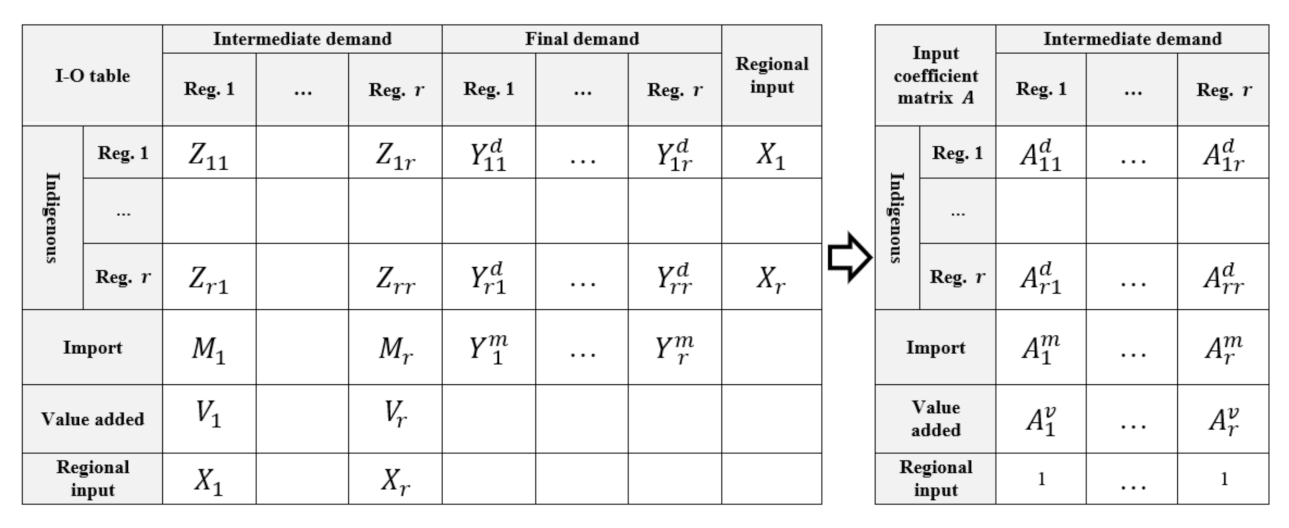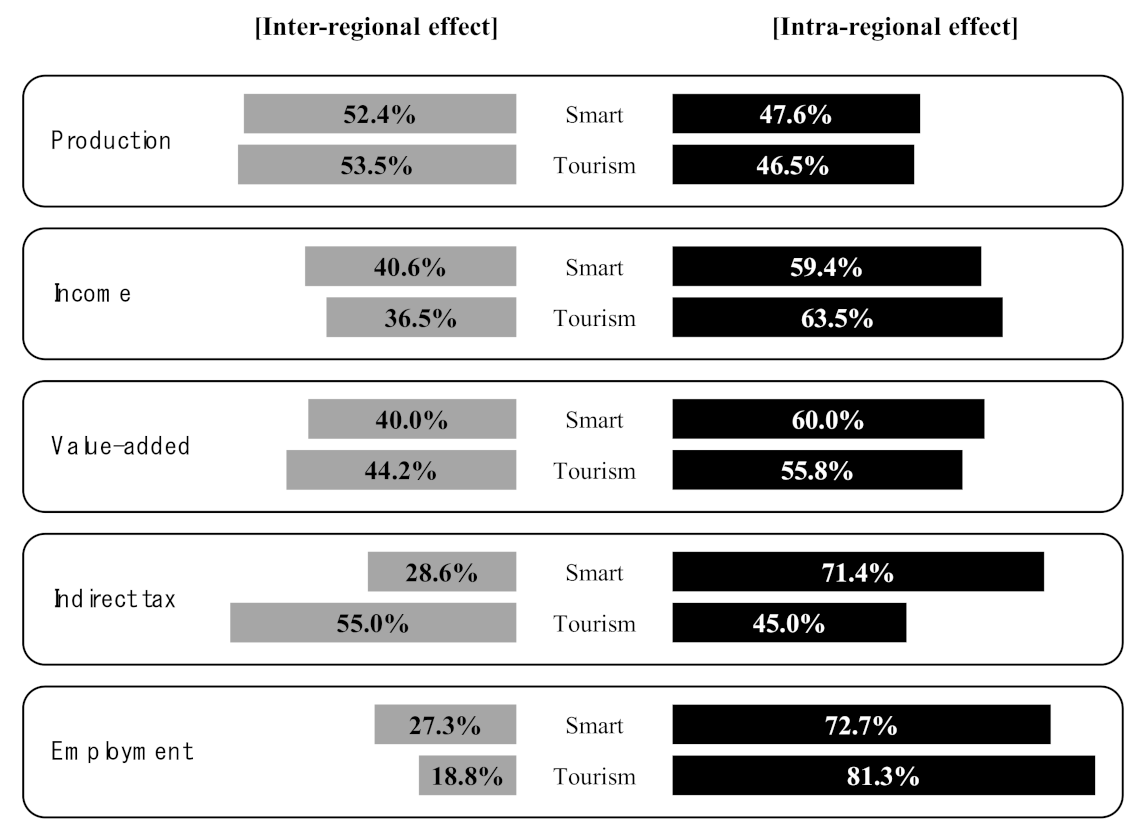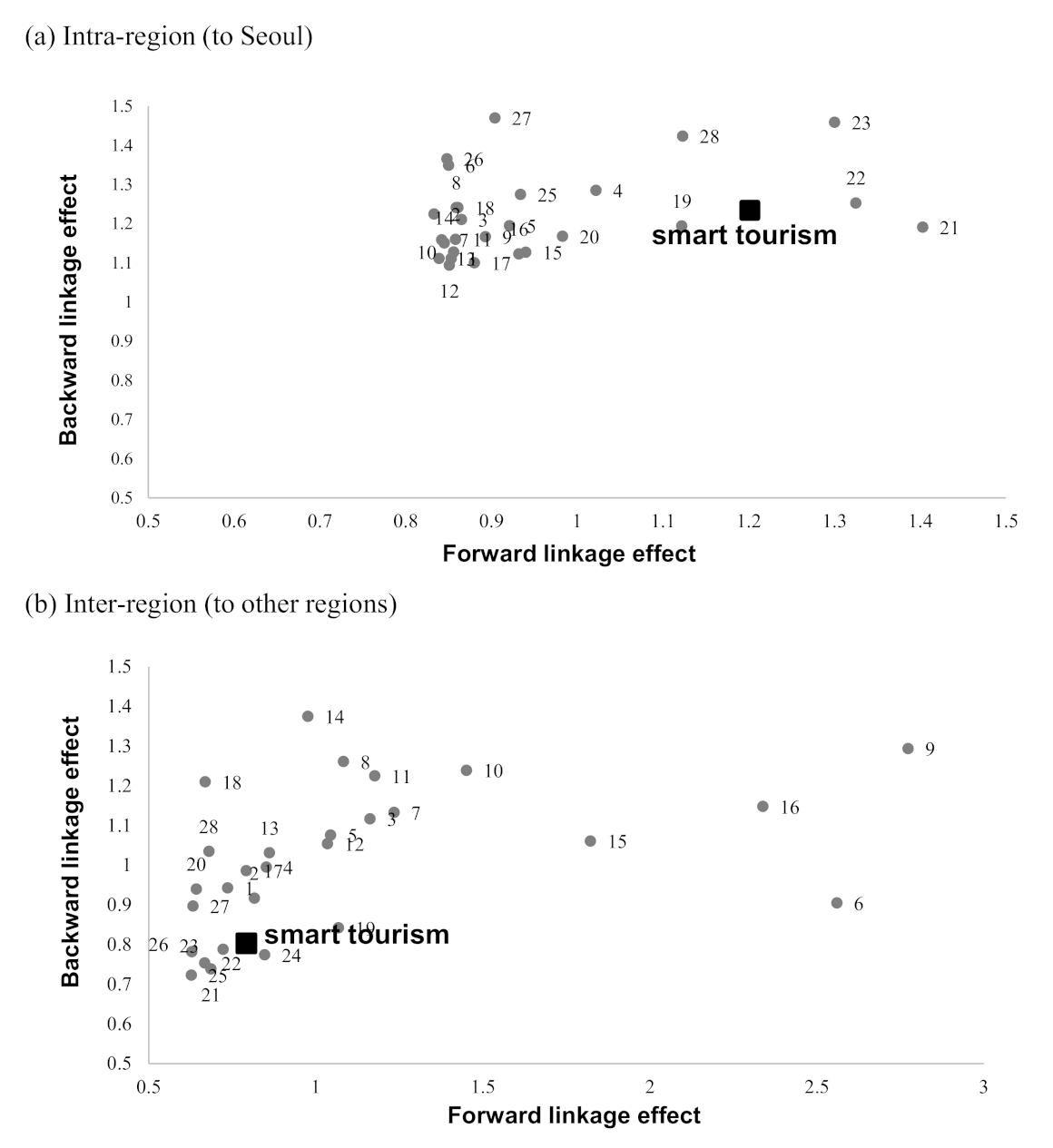The Intra- and Inter-Regional Economic Effects of Smart Tourism City Seoul: Analysis Using an Input-Output Model
Abstract
1. Introduction
- RQ1: How much does a smart tourism city contribute to the economies of the city itself and its nearby regions?
- RQ2: How does the smart tourism industry have economic relationships with other industries in a smart tourism city?
2. Theoretical Background
2.1. Definition of a Smart Tourism City
2.2. Economic Effects of a Smart Tourism City
2.3. Inter-Regional Input–Output Model
3. Research Design
4. Analysis and Results
4.1. Smart Tourism Industries
4.2. The Intra- and Inter-Regional Economic Effects
4.3. Forward and Backward Linkage Effects
5. Discussion and Conclusions
Author Contributions
Funding
Institutional Review Board Statement
Informed Consent Statement
Data Availability Statement
Acknowledgments
Conflicts of Interest
References
- Sigala, M. Tourism and COVID-19: Impacts and implications for advancing and resetting industry and research. J. Bus. Res. 2020, 312–321. [Google Scholar] [CrossRef]
- Gretzel, U.; Fuchs, M.; Baggio, R.; Hoepken, W.; Law, R.; Neidhardt, J.; Pesonen, J.; Zanker, M.; Xiang, Z. e-Tourism beyond COVID-19: A call for transformative research. Inf. Technol. Tour. 2020, 22, 187–203. [Google Scholar] [CrossRef]
- Chok, S.; Macbeth, J.; Warren, C. Tourism as a tool for poverty alleviation: A critical analysis of ‘pro-poor tourism’ and implications for sustainability. Curr. Issues Tour. 2007, 10, 144–165. [Google Scholar] [CrossRef]
- Chung, N.; Lee, H.; Ham, J.; Koo, C. Smart Tourism Cities’ Competitiveness Index: A Conceptual Model. In Information and Communication Technologies in Tourism 2021; Springer: Cham, Switzerland, 2021; pp. 433–438. [Google Scholar]
- Hall, C.M.; Prayag, G.; Amore, A. Tourism and Resilience: Individual, Organizational and Destination Perspectives; Channel View Publications: Bristol, UK, 2017. [Google Scholar]
- Kim, K.; Jung, J.K.; Choi, J.Y. Impact of the smart city industry on the Korean national economy: Input-output analysis. Sustainability 2016, 8, 649. [Google Scholar] [CrossRef]
- Koo, C.; Mendes Filho, L.; Buhalis, D. Smart tourism and competitive advantage for stakeholders. Tour. Rev. 2019, 74, 1–128. [Google Scholar] [CrossRef]
- The Korea Times. Government to Create ‘Smart’ Tourist City. Available online: http://www.koreatimes.co.kr/www/culture/2021/01/141_284087.html (accessed on 27 February 2020).
- ChungWaDae. Opening Remarks by President Moon Jae-in at Expended Tourism Strategy Meeting. Available online: https://english1.president.go.kr/BriefingSpeeches/Economy/562 (accessed on 2 April 2019).
- Seoul Tourism Organization (2020.12). Smart Tourism Cities’ Competitiveness Index: Final Report. Available online: http://www.sto.or.kr/press/10718_/10718 (accessed on 5 April 2021).
- Shin, Y.J.; Suh, W. A Study on the Impact of the Smart Tourism Industry on the Korean Economy. E-Bus. Stud. 2017, 18, 291–307. [Google Scholar] [CrossRef]
- Lee, H.; Koo, C.; Chung, N. The economic impacts of smart tourism: Analysis using an input-output model. J. Hosp. Tour. Stud. 2020, 22, 1–12. [Google Scholar] [CrossRef]
- Lee, H.; Yang, S.B.; Chung, N. The Internal and External Economic Effects of Smart Tourism City, Busan: Analysis Using an Inter-Regional Input-Ouput Model. J. Tour. Leis. Res. 2019, 31, 87–101. [Google Scholar]
- Gretzel, U.; Koo, C. Smart tourism cities: A duality of place where technology supports the convergence of touristic and residential experiences. Asia Pac. J. Tour. Res. 2021, 26. [Google Scholar] [CrossRef]
- Hollands, R.G. Will the real smart city please stand up? Intelligent, progressive or entrepre-neurial? City 2008, 12, 303–320. [Google Scholar] [CrossRef]
- Celino, I.; Kotoulas, S. Smart cities [guest editors’ introduction]. IEEE Internet Comput. 2013, 17, 8–11. [Google Scholar] [CrossRef]
- Isi lab. Smart City Index Report. 2017. Available online: http://isi-en.yonsei.ac.kr/download/2017-smart-city-index-report/ (accessed on 28 October 2020).
- Boes, K.; Buhalis, D.; Inversini, A. Smart tourism destinations: Ecosystems for tourism destination competitiveness. Int. J. Tour. Cities 2016, 2, 108–124. [Google Scholar] [CrossRef]
- Gretzel, U.; Werthner, H.; Koo, C.; Lamsfus, C. Conceptual foundations for understanding smart tourism ecosystems. Comput. Hum. Behav. 2015, 50, 558–563. [Google Scholar] [CrossRef]
- Gretzel, U.; Sigala, M.; Xiang, Z.; Koo, C. Smart tourism: Foundations and developments. Electron. Mark. 2015, 25, 179–188. [Google Scholar] [CrossRef]
- Gretzel, U.; Zhong, L.; Koo, C. Application of smart tourism to cities. Int. J. Tour. Cities 2016, 2, 216–233. [Google Scholar] [CrossRef]
- Lee, P.; Hunter, W.C.; Chung, N. Smart Tourism City: Developments and Transformations. Sustainability 2020, 12, 3958. [Google Scholar] [CrossRef]
- European Union (EU) Compendium of Best Practices: 2019 European Capital of Smart Tourism Competition. Available online: https://smarttourismcapital.eu/ (accessed on 28 October 2020).
- Buhalis, D.; Amaranggana, A. Smart tourism destinations. In Information and Communication Technologies in Tourism 2014; Springer: Cham, Switzerland, 2014; pp. 553–564. [Google Scholar]
- Archer, B.; Cooper, C.; Ruhanen, L. The positive and negative impacts of tourism. In Global Tourism; Theobald, W.F., Ed.; Elsevier Inc.: Burlington, MA, USA, 2005; pp. 79–102. [Google Scholar]
- Shin, H.; Kang, J. Reducing perceived health risk to attract hotel customers in the COVID-19 pandemic era: Focused on technology innovation for social distancing and cleanliness. Int. J. Hosp. Manag. 2020, 91, 102664. [Google Scholar] [CrossRef]
- Guttentag, D.A. Virtual reality: Applications and implications for tourism. Tour. Manag. 2010, 31, 637–651. [Google Scholar] [CrossRef]
- The Bank of Korea. 2010/2013 Regional Input-Output Statistics 2015. 2015a. Available online: https://www.bok.or.kr/portal/bbs/P0001588/view.do?nttId=215621&menuNo=200457 (accessed on 8 February 2021).
- Isard, W. Interregional and regional input-output analysis: A model of a space-economy. Rev. Econ. Stat. 1951, 33, 318–328. [Google Scholar] [CrossRef]
- Lee, C.K.; Mjelde, J.W.; Kwon, Y.J. Estimating the economic impact of a mega-event on host and neighbouring regions. Leis. Stud. 2017, 36, 138–152. [Google Scholar] [CrossRef]
- Zhang, Y.; Zhao, K. Impact of Beijing Olympic-related Investments on Regional Economic Growth of China: Interregional Input–Output Approach. Asian Econ. J. 2007, 21, 261–282. [Google Scholar] [CrossRef]
- Pérez, J.; Dones, M.; Llano, C. An interregional impact analysis of the EU structural funds in Spain (1995–1999). Pap. Reg. Sci. 2009, 88, 509–529. [Google Scholar] [CrossRef]
- Lee, C.K.; Lee, M.; Yoon, S.H. Estimating the economic impact of convention and exhibition businesses, using a regional input–output model: A case study of the Daejeon Convention Center in South Korea. Asia Pac. J. Tour. Res. 2013, 18, 330–353. [Google Scholar] [CrossRef]
- Jun, W.K.; Lee, M.K.; Choi, J.Y. Impact of the smart port industry on the Korean national economy using input-output analysis. Transp. Res. Part A Policy Pract. 2018, 118, 480–493. [Google Scholar] [CrossRef]
- Lee, C.K. Applied Economics of Tourism, 2nd ed.; Daewangsa: Seoul, Korea, 2017. [Google Scholar]
- The Bank of Korea. 2013 Input-Output Statistics, The Executive Summary of the 2013 Input-Output Table; The Bank of Korea: Seoul, Korea, 2015. [Google Scholar]
- Lee, C.K.; Taylor, T. Critical reflections on the economic impact assessment of a mega-event: The case of 2002 FIFA World Cup. Tour. Manag. 2005, 26, 595–603. [Google Scholar] [CrossRef]
- San Cristobal, J.R.; Biezma, M.V. The mining industry in the European Union: Analysis of inter-industry linkages using input–output analysis. Resour. Policy 2006, 31, 1–6. [Google Scholar] [CrossRef]
- Lee, C.K.; Song, H.J.; Moon, J.H. Estimating the Economic Impact of Inbound Tourism Industry using an Inter-Regional Input-Output Model: Case of Jongno. Korea J. Tour. Res. 2021, 26, 415–433. [Google Scholar]
- Sawng, Y.W.; Xu, Y.; Shin, J.H.; Kim, M. Economic ripple effect analysis of new converging industry: Focusing on inter-industrial analysis of Fintech industry in South Korea, China and the United States. J. Sci. Ind. Res. 2020, 79, 116–121. [Google Scholar]
- Stone, R.; Bacharach, M.; Bates, J. Input-Output Relationships 1951–1966; Programme for Growth; Chapman and Hall: London, UK, 1963; Volume 3. [Google Scholar]
- Lee, D.H.; Lee, D.J.; Chiu, L.H. Biohydrogen development in United States and in China: An input–output model study. Int. J. Hydrog. Energy 2011, 36, 14238–14244. [Google Scholar] [CrossRef]





| Category | Scholar | Purpose |
|---|---|---|
| Mega-event | Lee et al. (2017) | Estimation of economic effects of the 2012 Yeosu Expo in Korea on the host city and its nearby regions |
| Investment or fund | Zhang & Zhao (2007) | Estimation of the economic effects of the 2018 Beijing Olympic-related investments on Beijing, its surrounding areas, and the rest of China |
| Pérez et al. (2009) | Estimation of the economic effects of the EU structural funds on Spanish regions | |
| Specific industries | Lee et al. (2013) | Estimation of the economic effects of convention and exhibition business on Daegu (a city in South Korea) |
| Lee et al. (2019) | Estimation of the economic effects of tourists’ expenditure in smart tourism city Busan (a city in South Korea) |
| Types of Coefficient | Definition | Formula |
|---|---|---|
| Production | The ripple effect of one unit change in investment on change in business turnover | The column sums of the production inducement coefficient matrix |
| Income | The ripple effect of one unit change in investment on change in personal income for residents | is an inducement coefficient matrix for income |
| Value-added | The ripple effect of one unit change in investment on change in value-added | is an inducement coefficient matrix for value-added |
| Indirect tax | The ripple effect of one unit change in investment on change in indirect tax | is an inducement coefficient matrix for indirect tax |
| Employment | The number of jobs created from one unit increase in investment | is an inducement coefficient matrix for employment |
| Category | Sector | Percentage | 5-Point Scale Score (Mean) |
|---|---|---|---|
| Smart tourism | Computers and Peripherals | 75.0 | 4.17 |
| Communication, Broadcasting, Video and Sound Equipment | 83.3 | 4.50 | |
| Telecommunications Services | 100 | 4.75 | |
| Broadcasting Service | 91.7 | 4.33 | |
| Information Service | 100 | 4.58 | |
| Supply for Software Development and Other IT Services | 91.7 | 4.50 | |
| Motion Picture and Video Production and Distribution | 66.7 | 4.33 | |
| Research and Development | 50.0 | 4.08 | |
| Wholesale and Retail Service | 91.7 | 4.33 | |
| Road Transport Services | 91.7 | 4.50 | |
| Water Transport Services | 83.3 | 4.08 | |
| Air Freight Service | 91.7 | 4.50 | |
| Restaurant and Accommodation Services | 100 | 4.67 | |
| Cultural Services | 100 | 4.67 | |
| Sports and Entertainment Services | 100 | 4.08 |
| Industry Sector | Production | Income | |||||
|---|---|---|---|---|---|---|---|
| Intra | Inter | Total | Intra | Inter- | Total | ||
| 1 | Agricultural, forestry and fisheries | 1.111 | 1.506 | 2.617 | 0.191 | 0.226 | 0.417 |
| 2 | Mining products | 1.225 | 1.464 | 2.689 | 0.225 | 0.224 | 0.449 |
| 3 | Food products and beverages | 1.211 | 1.783 | 2.994 | 0.152 | 0.204 | 0.356 |
| 4 | Textile and leather products | 1.285 | 1.588 | 2.874 | 0.137 | 0.167 | 0.304 |
| 5 | Wood and paper products, printing, and replication | 1.195 | 1.718 | 2.913 | 0.198 | 0.263 | 0.460 |
| 6 | Petroleum and coal products | 1.349 | 1.444 | 2.793 | 0.186 | 0.174 | 0.361 |
| 7 | Chemicals | 1.159 | 1.809 | 2.968 | 0.153 | 0.213 | 0.366 |
| 8 | Non-metallic mineral products | 1.241 | 2.012 | 3.253 | 0.123 | 0.180 | 0.303 |
| 9 | Primary metal products | 1.167 | 2.066 | 3.233 | 0.133 | 0.239 | 0.372 |
| 10 | Metal products | 1.128 | 1.977 | 3.105 | 0.125 | 0.221 | 0.347 |
| 11 | General machinery | 1.160 | 1.955 | 3.114 | 0.171 | 0.268 | 0.439 |
| 12 | Electrical and electronic equipment | 1.094 | 1.682 | 2.777 | 0.158 | 0.240 | 0.398 |
| 13 | Precision instruments | 1.111 | 1.645 | 2.757 | 0.115 | 0.252 | 0.367 |
| 14 | Transport equipment | 1.151 | 2.195 | 3.346 | 0.162 | 0.286 | 0.448 |
| 15 | Other manufacturing products | 1.127 | 1.693 | 2.820 | 0.138 | 0.373 | 0.511 |
| 16 | Electricity, gas, steam, and air conditioning supply | 1.123 | 1.832 | 2.956 | 0.230 | 0.134 | 0.364 |
| 17 | Water supply, sewerage, waste management, and remediation | 1.100 | 1.574 | 2.674 | 0.136 | 0.270 | 0.405 |
| 18 | Construction | 1.241 | 1.931 | 3.172 | 0.253 | 0.385 | 0.638 |
| 19 | Transportation | 1.194 | 1.344 | 2.538 | 0.296 | 0.325 | 0.620 |
| 20 | Communications and broadcasting (general) | 1.168 | 1.501 | 2.669 | 0.315 | 0.337 | 0.652 |
| 21 | Finance and insurance | 1.191 | 1.179 | 2.370 | 0.219 | 0.264 | 0.483 |
| 22 | Real estate and business service (general) | 1.253 | 1.203 | 2.457 | 0.231 | 0.178 | 0.410 |
| 23 | Professional, scientific, and technical activities | 1.459 | 1.258 | 2.717 | 0.370 | 0.426 | 0.797 |
| 24 | Administrative and support service activities | 1.393 | 1.235 | 2.628 | 0.313 | 0.508 | 0.821 |
| 25 | Public administration and defense, compulsory social security | 1.275 | 1.154 | 2.428 | 0.408 | 0.516 | 0.924 |
| 26 | Education | 1.366 | 1.248 | 2.615 | 0.350 | 0.606 | 0.956 |
| 27 | Human health and social work activities | 1.470 | 1.432 | 2.903 | 0.271 | 0.429 | 0.700 |
| 28 | Other service activities | 1.424 | 1.651 | 3.075 | 0.476 | 0.369 | 0.845 |
| Non-Smart Tourism (mean) | 1.197 | 1.644 | 2.841 | 0.197 | 0.264 | 0.462 | |
| 29 | Smart tourism | 1.234 | 1.388 | 2.622 | 0.382 | 0.241 | 0.623 |
| Value Added | Indirect Tax | Employment | ||||||
|---|---|---|---|---|---|---|---|---|
| Intra | Inter | Total | Intra | Inter | Total | Intra | Inter | Total |
| 0.606 | 0.693 | 1.299 | 0.042 | 0.043 | 0.085 | 0.021 | 0.004 | 0.025 |
| 0.626 | 0.654 | 1.280 | 0.005 | 0.006 | 0.011 | 0.004 | 0.003 | 0.007 |
| 0.354 | 0.492 | 0.846 | 0.002 | 0.005 | 0.007 | 0.006 | 0.009 | 0.015 |
| 0.327 | 0.376 | 0.703 | 0.002 | 0.002 | 0.005 | 0.007 | 0.005 | 0.011 |
| 0.381 | 0.502 | 0.883 | 0.002 | 0.004 | 0.006 | 0.014 | 0.004 | 0.018 |
| 0.421 | 0.403 | 0.823 | 0.002 | 0.002 | 0.004 | 0.005 | 0.005 | 0.010 |
| 0.313 | 0.446 | 0.759 | 0.002 | 0.003 | 0.005 | 0.008 | 0.003 | 0.012 |
| 0.315 | 0.488 | 0.803 | 0.002 | 0.004 | 0.006 | 0.006 | 0.005 | 0.011 |
| 0.254 | 0.442 | 0.696 | 0.002 | 0.003 | 0.005 | 0.006 | 0.004 | 0.010 |
| 0.239 | 0.423 | 0.662 | 0.002 | 0.003 | 0.005 | 0.007 | 0.003 | 0.010 |
| 0.313 | 0.484 | 0.797 | 0.002 | 0.003 | 0.005 | 0.007 | 0.004 | 0.011 |
| 0.378 | 0.500 | 0.879 | 0.002 | 0.003 | 0.005 | 0.008 | 0.003 | 0.011 |
| 0.251 | 0.490 | 0.741 | 0.002 | 0.003 | 0.004 | 0.007 | 0.003 | 0.010 |
| 0.287 | 0.488 | 0.775 | 0.002 | 0.003 | 0.005 | 0.006 | 0.005 | 0.011 |
| 0.222 | 0.599 | 0.821 | 0.001 | 0.003 | 0.004 | 0.016 | 0.004 | 0.020 |
| 0.393 | 0.544 | 0.936 | 0.002 | 0.002 | 0.004 | 0.007 | 0.001 | 0.008 |
| 0.431 | 0.651 | 1.082 | 0.002 | 0.004 | 0.005 | 0.009 | 0.003 | 0.012 |
| 0.521 | 0.563 | 1.084 | 0.004 | 0.007 | 0.011 | 0.009 | 0.004 | 0.014 |
| 0.393 | 0.617 | 1.010 | 0.006 | 0.004 | 0.011 | 0.012 | 0.004 | 0.015 |
| 0.418 | 0.479 | 0.898 | 0.006 | 0.006 | 0.012 | 0.013 | 0.004 | 0.017 |
| 0.412 | 0.532 | 0.944 | 0.005 | 0.003 | 0.008 | 0.009 | 0.003 | 0.012 |
| 0.489 | 0.685 | 1.174 | 0.006 | 0.016 | 0.021 | 0.009 | 0.002 | 0.010 |
| 0.679 | 0.666 | 1.345 | 0.005 | 0.004 | 0.009 | 0.012 | 0.002 | 0.014 |
| 0.603 | 0.736 | 1.339 | 0.006 | 0.004 | 0.010 | 0.026 | 0.002 | 0.028 |
| 0.679 | 0.829 | 1.507 | 0.005 | 0.000 | 0.006 | 0.010 | 0.001 | 0.011 |
| 0.493 | 0.786 | 1.279 | 0.006 | 0.003 | 0.009 | 0.015 | 0.002 | 0.017 |
| 0.634 | 0.602 | 1.236 | 0.005 | 0.003 | 0.007 | 0.017 | 0.004 | 0.021 |
| 0.637 | 0.658 | 1.295 | 0.004 | 0.005 | 0.009 | 0.025 | 0.003 | 0.028 |
| 0.415 | 0.546 | 0.961 | 0.006 | 0.007 | 0.013 | 0.010 | 0.003 | 0.014 |
| 0.691 | 0.497 | 1.189 | 0.009 | 0.008 | 0.017 | 0.010 | 0.003 | 0.013 |
| Industry Sector | Forward Linkage Effect | Ranking | Backward Linkage Effect | Ranking | |
|---|---|---|---|---|---|
| 1 | Agricultural, forestry and fisheries | 0.853 | 22 | 1.111 | 26 |
| 2 | Mining products | 0.833 | 29 | 1.225 | 13 |
| 3 | Food products and beverages | 0.865 | 17 | 1.211 | 14 |
| 4 | Textile and leather products | 1.022 | 8 | 1.285 | 7 |
| 5 | Wood and paper products, printing, and replication | 0.921 | 13 | 1.195 | 15 |
| 6 | Petroleum and coal products | 0.850 | 24 | 1.349 | 6 |
| 7 | Chemicals | 0.842 | 27 | 1.159 | 21 |
| 8 | Non-metallic mineral products | 0.859 | 19 | 1.241 | 10 |
| 9 | Primary metal products | 0.893 | 15 | 1.167 | 19 |
| 10 | Metal products | 0.856 | 21 | 1.128 | 23 |
| 11 | General machinery | 0.858 | 20 | 1.160 | 20 |
| 12 | Electrical and electronic equipment | 0.851 | 23 | 1.094 | 29 |
| 13 | Precision instruments | 0.839 | 28 | 1.111 | 26 |
| 14 | Transport equipment | 0.845 | 26 | 1.151 | 22 |
| 15 | Other manufacturing products | 0.940 | 10 | 1.127 | 24 |
| 16 | Electricity, gas, steam, and air conditioning supply | 0.932 | 12 | 1.123 | 25 |
| 17 | Water supply, sewerage, waste management, and remediation | 0.880 | 16 | 1.100 | 28 |
| 18 | Construction | 0.861 | 18 | 1.241 | 10 |
| 19 | Transportation | 1.122 | 7 | 1.194 | 16 |
| 20 | Communications and broadcasting (general) | 0.983 | 9 | 1.168 | 18 |
| 21 | Finance and insurance | 1.403 | 2 | 1.191 | 17 |
| 22 | Real estate and business service (general) | 1.325 | 3 | 1.253 | 9 |
| 23 | Professional, scientific, and technical activities | 1.300 | 4 | 1.459 | 2 |
| 24 | Administrative and support service activities | 1.534 | 1 | 1.393 | 4 |
| 25 | Public administration and defense, compulsory social security | 0.934 | 11 | 1.275 | 8 |
| 26 | Education | 0.848 | 25 | 1.366 | 5 |
| 27 | Human health and social work activities | 0.904 | 14 | 1.470 | 1 |
| 28 | Other service activities | 1.123 | 6 | 1.424 | 3 |
| 29 | Smart tourism | 1.202 | 5 | 1.234 | 12 |
| Industry Sector | Forward Linkage Effect | Ranking | Backward Linkage Effect | Ranking | |
|---|---|---|---|---|---|
| 1 | Agricultural, forestry and fisheries | 0.736 | 20 | 0.943 | 17 |
| 2 | Mining products | 0.816 | 18 | 0.917 | 19 |
| 3 | Food products and beverages | 1.162 | 8 | 1.117 | 9 |
| 4 | Textile and leather products | 0.852 | 16 | 0.995 | 15 |
| 5 | Wood and paper products, printing, and replication | 1.044 | 11 | 1.076 | 10 |
| 6 | Petroleum and coal products | 2.560 | 2 | 0.905 | 20 |
| 7 | Chemicals | 1.234 | 6 | 1.133 | 8 |
| 8 | Non-metallic mineral products | 1.083 | 9 | 1.261 | 3 |
| 9 | Primary metal products | 2.773 | 1 | 1.294 | 2 |
| 10 | Metal products | 1.451 | 5 | 1.239 | 4 |
| 11 | General machinery | 1.176 | 7 | 1.225 | 5 |
| 12 | Electrical and electronic equipment | 1.035 | 12 | 1.054 | 12 |
| 13 | Precision instruments | 0.861 | 15 | 1.031 | 14 |
| 14 | Transport equipment | 0.976 | 13 | 1.375 | 1 |
| 15 | Other manufacturing products | 1.822 | 4 | 1.061 | 11 |
| 16 | Electricity, gas, steam, and air conditioning supply | 2.338 | 3 | 1.148 | 7 |
| 17 | Water supply, sewerage, waste management, and remediation | 0.792 | 19 | 0.986 | 16 |
| 18 | Construction | 0.669 | 25 | 1.210 | 6 |
| 19 | Transportation | 1.068 | 10 | 0.842 | 24 |
| 20 | Communications and broadcasting (general) | 0.642 | 27 | 0.940 | 18 |
| 21 | Finance and insurance | 0.686 | 23 | 0.739 | 29 |
| 22 | Real estate and business service (general) | 0.667 | 26 | 0.754 | 28 |
| 23 | Professional, scientific, and technical activities | 0.722 | 21 | 0.788 | 25 |
| 24 | Administrative and support service activities | 0.847 | 17 | 0.774 | 27 |
| 25 | Public administration and defense, compulsory social security | 0.627 | 30 | 0.723 | 30 |
| 26 | Education | 0.629 | 29 | 0.782 | 26 |
| 27 | Human health and social work activities | 0.632 | 28 | 0.897 | 21 |
| 28 | Other service activities | 0.680 | 24 | 1.035 | 13 |
| 29 | Smart tourism | 0.793 | 22 | 0.802 | 23 |
Publisher’s Note: MDPI stays neutral with regard to jurisdictional claims in published maps and institutional affiliations. |
© 2021 by the authors. Licensee MDPI, Basel, Switzerland. This article is an open access article distributed under the terms and conditions of the Creative Commons Attribution (CC BY) license (https://creativecommons.org/licenses/by/4.0/).
Share and Cite
Lee, H.; Hlee, S. The Intra- and Inter-Regional Economic Effects of Smart Tourism City Seoul: Analysis Using an Input-Output Model. Sustainability 2021, 13, 4031. https://doi.org/10.3390/su13074031
Lee H, Hlee S. The Intra- and Inter-Regional Economic Effects of Smart Tourism City Seoul: Analysis Using an Input-Output Model. Sustainability. 2021; 13(7):4031. https://doi.org/10.3390/su13074031
Chicago/Turabian StyleLee, Hyunae, and Sunyoung Hlee. 2021. "The Intra- and Inter-Regional Economic Effects of Smart Tourism City Seoul: Analysis Using an Input-Output Model" Sustainability 13, no. 7: 4031. https://doi.org/10.3390/su13074031
APA StyleLee, H., & Hlee, S. (2021). The Intra- and Inter-Regional Economic Effects of Smart Tourism City Seoul: Analysis Using an Input-Output Model. Sustainability, 13(7), 4031. https://doi.org/10.3390/su13074031






